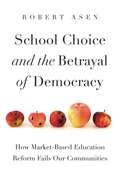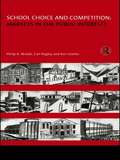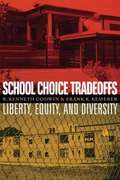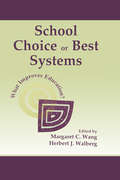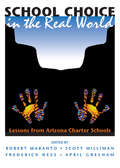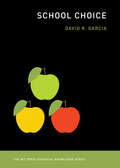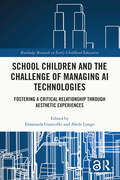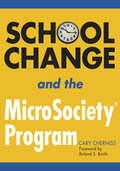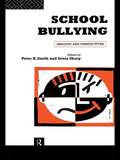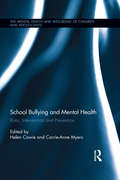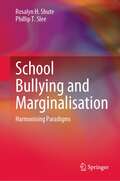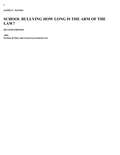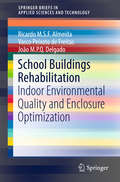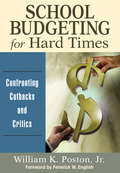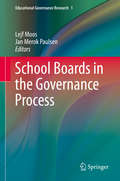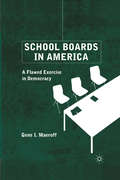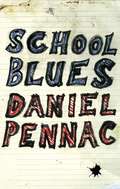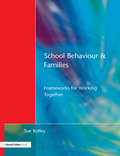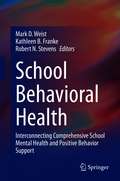- Table View
- List View
School Choice and the Betrayal of Democracy: How Market-Based Education Reform Fails Our Communities (Rhetoric and Democratic Deliberation)
by Robert AsenEvidence shows that the increasing privatization of K–12 education siphons resources away from public schools, resulting in poorer learning conditions, underpaid teachers, and greater inequality. But, as Robert Asen reveals here, the damage that market-based education reform inflicts on society runs much deeper. At their core, these efforts are antidemocratic.Arguing that democratic communities and public education need one another, Asen examines the theory driving privatization, popularized in the neoliberalism of Milton and Rose Friedman, as well as the case for school choice promoted by former secretary of education Betsy DeVos and the controversial voucher program of former Wisconsin governor Scott Walker. What Asen finds is that a market-based approach holds not just a different view of distributing education but a different vision of society. When the values of the market—choice, competition, and self-interest—shape national education, that policy produces individuals, Asen contends, with no connections to community and no obligations to one another. The result is a society at odds with democracy.Probing and thought-provoking, School Choice and the Betrayal of Democracy features interviews with local, on-the-ground advocates for public education and offers a countering vision of democratic education—one oriented toward civic relationships, community, and equality. This book is essential reading for policymakers, advocates of public education, citizens, and researchers.
School Choice and the Betrayal of Democracy: How Market-Based Education Reform Fails Our Communities (Rhetoric and Democratic Deliberation #26)
by Robert AsenEvidence shows that the increasing privatization of K–12 education siphons resources away from public schools, resulting in poorer learning conditions, underpaid teachers, and greater inequality. But, as Robert Asen reveals here, the damage that market-based education reform inflicts on society runs much deeper. At their core, these efforts are antidemocratic.Arguing that democratic communities and public education need one another, Asen examines the theory driving privatization, popularized in the neoliberalism of Milton and Rose Friedman, as well as the case for school choice promoted by former secretary of education Betsy DeVos and the controversial voucher program of former Wisconsin governor Scott Walker. What Asen finds is that a market-based approach holds not just a different view of distributing education but a different vision of society. When the values of the market—choice, competition, and self-interest—shape national education, that policy produces individuals, Asen contends, with no connections to community and no obligations to one another. The result is a society at odds with democracy.Probing and thought-provoking, School Choice and the Betrayal of Democracy features interviews with local, on-the-ground advocates for public education and offers a countering vision of democratic education—one oriented toward civic relationships, community, and equality. This book is essential reading for policymakers, advocates of public education, citizens, and researchers.
School Choice and Competition: Markets in the Public Interest? (Educational Management Ser.)
by Ron Glatter Carl Bagley Philip WoodsThis book offers a unique record of the realities of parental choice and competitive pressures on schools. On the basis of research involving thousands of parents and eleven secondary schools monitored over several years, it sets out: * empirical findings on parents' preferences and experience of choice, how schools respond to competitive pressures, and local dynamics of quasi-markets * theoretical implications for understanding quasi-markets in education and the public interest * implications for educational policy, if schools are to be more responsive and inequalities lessened The book provides insights into whether pressures for choice and diversity are in the greater public interest, or if they benefit only the few, and suggests a notion of the public-market as a model for analysing public services.
School Choice Tradeoffs: Liberty, Equity, and Diversity
by R. Kenneth Godwin Frank R. KemererEducational policy in a democracy goes beyond teaching literacy and numeracy. It also supports teaching moral reasoning, political tolerance, respect for diversity, and citizenship. <P>Education policy should encourage liberty and equality of opportunity, hold educational institutions accountable, and be efficient. School Choice Tradeoffs examines the tradeoffs among these goals when government affords parents the means to select the schools their children attend. <P><P> Godwin and Kemerer compare current policy that uses family residence to assign students to schools with alternative policies that range from expanding public choice options to school vouchers. They identify the benefits and costs of each policy approach through a review of past empirical literature, the presentation of new empirical work, and legal and philosophic analysis.
School Choice Or Best Systems: What Improves Education?
by Herbert J. Walberg Margaret C. WangThis book addresses one of the most urgent questions in American society today, one that is currently in the spotlight and hotly debated on all sides: Who shall rule the schools--parents or educators? School Choice or Best Systems: What Improves Education? presents an overview of research and practical applications of innovative--even radical--school reforms being implemented across the United States. These fall along a continuum ranging from "parental choice" to "best systems." At the one extreme are schools of choice, which allow parents to choose and even govern schools for their children. These include charter schools, traditional private and parochial schools, schools that are privately governed but publicly funded through vouchers, and those that are funded by private scholarships provided by both corporations and wealthy individuals. At the other extreme are centralized state or district systems, based on reform initiatives and new systems of education that have been developed in response to views of citizens and legislators that schools can do much better. These schools, which specify uniform goals, policies, and programs for each school, are highly innovative systems based on research or representing advanced thinking about "what works," and have attracted wide interest. Important questions related to schools of choice and best systems are addressed: How can we choose among schools of choice and best systems? Among the various approaches within each of these alternatives? How can we understand their guiding principles and operational practices? What results do they produce? How can we evaluate their claims? In choosing among the alternatives, how should issues of student achievement, accountability, costs, feasibility, and equity be factored in? This volume brings together leading researchers and education leaders who have carried out the latest studies and advances in the field, providing a forum for them to set forth the arguments and evidence that will be most helpful in making choices for tomorrow's schools. It does not provide a single "right" answer--values and preferences differ across parents, schools, districts, and states. However, there are benefits for all from seeing the rigorous research, challenging thinking, and alternate points of view this volume presents.
School Choice In The Real World: Lessons From Arizona Charter Schools
by Robert MarantoThis book presents the first published accounts and evaluations of the first free market in education in the U.S., Arizona charter schools.. The charter school is fast becoming one of the most significant attempts at public education reform in this country. Over 1100 charter schools operate in twenty-seven states, with several hundred more to be added in the next two years. School Choice in the Real World looks at the charter school movement through a highly focused lens: it examines charter schools in Arizona, which currently account for nearly one-quarter of all charter schools. Using this state as a case study, the editors examine the experiences of actual charter school operators, social scientific analysis, policy discussions, and criticism and forecasting for the future. School choice is the most talked about reform of American public education, yet writings about choice remain highly speculative because no state has adopted a free market approach to education--until now. The charter school is fast becoming one of the most significant attempts at public education reform in this country. Over 1100 charter schools operate in twenty-seven states, with several hundred more to be added in the next two years. School Choice in the Real World looks at the charter school movement through a highly focused lens: it examines charter schools in Arizona, which currently account for nearly one-quarter of all charter schools.Since 1994, Arizona has implemented a charter school law with the lowest barriers to entry in the nation. As a result, Arizona has more than 200 charter school campuses. Some districts have even lost more than 10% of their students to charter schools. Using the state of Arizona as a case study, the editors examine the experiences of actual charter school operators, social scientific analysis, policy discussions, and criticism and forecasting for the future. The editors bring together academics, policy-makers, and practicioners, and they explain and evaluate how school choice works in the real world.
School Choice (The MIT Press Essential Knowledge series)
by David R. GarciaAn accessible guide to the major issues and arguments surrounding school choice.The issues and arguments surrounding school choice are sometimes hijacked to make political points about government control, democratic ideals, the public good, and privatization. In this volume in the MIT Press Essential Knowledge series, David Garcia avoids partisan arguments to offer an accessible, objective, and comprehensive guide to school choice. He first outlines the different types of school choice, including home schooling, private schools, freedom-of-choice plans, magnet schools, charter schools, vouchers, and education savings accounts. Two themes emerge as particularly resonant in the American school choice debate: the long history of school desegregation, and debates over the roles and responsibilities of government. Is education a public good, for the collective benefit of society, or a private good, to benefit the individual?Garcia describes and evaluates the major arguments supporting school choice policies: the elimination of government bureaucracies, the introduction of competition into education through market forces, the promotion of parental choice, and the casting of school choice as a civil right. He examines the research on the effects of school choice and summarizes general trends. Finally, he considers how school choice policies are likely to evolve. He notes that the Trump administration's Secretary of Education, Betsy DeVos, is an advocate for school choice, and that the administration's budget allocations signal a deliberate shift from long-standing federal policies that provide supplemental funding for low-income schools. Instead, new policies provide incentives for low-income families to leave public schools altogether through choice. This book will be an essential resource for participating in the debates that are sure to follow.
School Children as Agents of Change: Raising up Critical Thinking and Judgement in the Early Years (Routledge Research in Early Childhood Education)
by Abele Longo Emanuela GuarcelloThis edited volume promotes the capacity for critical thinking and judgement in primary school-aged children in the face of the challenges that schools encounter in today’s society. Foregrounding critical thinking and judgement as essential capacities for children to develop, each chapter offers a space for reflection on the formation of the ability to think and judge in primary school. While presenting a robust conceptual and foundational framework, chapters focus on the educational-didactic practices deemed most authoritative due to their impact on, and their innovative qualities within, the educational landscape today. Themes affecting schools in both the global north and south are discussed, such as social relationships, children’s voices, life skills and digital education, well-being and health, as well as matters of social plurality, inequalities and discrimination, ecology, global economy and the decolonising of education from various international perspectives. Foregrounding real-world experience within the education system, this book will be of relevance to researchers, scholars and post-graduates in the fields of philosophy of education, moral education and child development. It will also be of interest to pre- and in-service primary education practitioners.
School Children and the Challenge of Managing AI Technologies: Fostering a Critical Relationship through Aesthetic Experiences (Routledge Research in Early Childhood Education)
by Abele Longo Emanuela GuarcelloThis edited volume recognises the need to cultivate a critical and acute understanding of AI technologies amongst primary and elementary school children, enabling them to meet the challenge of a human- and ethically oriented management of AI technologies.Focusing on school settings from both the national and international level to form comparative case studies, chapters present a robust conceptual and foundational framework within a global context as the idea of AI and our relationship to it advances apace. The book uses research garnered from interviews and observational data, qualitative and quantitative research, and theoretical findings gathered from single schools or institutions across the world. Providing an innovative perspective in promoting the importance of a critical, creative and ethical orientation based on aesthetic experiences, the book focuses on development in areas like visual arts, literature, environmental education, robotics, photography and screen education, movement and play.Ultimately, the book responds to an urgent and time-sensitive call to provide guidance on AI to primary education researchers and will be of interest to academics, scholars and researchers in the fields of primary and elementary education, technology in education, children's rights education, and moral and values education more broadly.
School Change and the MicroSociety® Program
by Professor Cary ChernissBe an agent of positive, enduring change with these specific strategies gleaned from the MicroSociety® program and apply them to your school improvement efforts.
School Buses on the Go (Bumba Books ® -- Machines That Go Ser.)
by Beth Bence ReinkeCarefully leveled text and fresh, vibrant photos engage young readers in learning about how school buses work. Age-appropriate critical thinking questions and a photo glossary help build nonfiction learning skills.
School Bullying: Insights and Perspectives
by Peter Smith Peter K Smith Sonia SharpGives a succinct and authoritative account of research into the nature and extent of bullying in schools, evaluating the success of different approaches to the problem.
School Bullying in Different Cultures
by Peter K. Smith Smith, Peter K. and Kwak, Keumjoo and Toda, Yuichi Keumjoo Kwak Yuichi TodaSchool bullying is widely recognised as an international problem, but publications have focussed on the Western tradition of research. A long tradition of research in Japan and South Korea, and more recently in mainland China and Hong Kong, has had much less exposure. There are important and interesting differences in the nature of school bullying in Eastern and Western countries, as the first two parts of this book demonstrate. The third part examines possible reasons for these differences - methodological issues, school systems, societal values and linguistic issues. The final part looks at the implications for interventions to reduce school bullying and what we can learn from experiences in other countries. This is the first volume to bring together these perspectives on school bullying from a range of Eastern as well as Western countries.
School Bullying and Mental Health: Risks, intervention and prevention (The Mental Health and Well-being of Children and Adolescents)
by Helen Cowie Carrie Anne MyersBullying amongst young people is a serious and pervasive problem, and recent rapid advances in electronic communication technologies have provided even more tools for bullies to exploit. School Bullying and Mental Health collates current research evidence and theoretical perspectives about school bullying in one comprehensive volume, identifying the nature and extent of bullying and cyberbullying at school, as well as its impact on children and young people’s emotional health and well-being. There are many negative consequences of bullying, and children and young people who have been victimised often suffer long-term psychological problems, such as increased levels of anxiety, depressive symptoms, social isolation, loneliness and suicidal ideation. Perpetrators of bullying also have a heightened risk of experiencing problems such as anxiety and depression, as well as eating disorders and antisocial behaviour. Founded on rigorous academic research, this important book tackles the negative consequences of bullying, and bullying culture itself, by examining the social and cultural contexts that perpetuate such behaviour from childhood through adolescence and potentially into adulthood. Containing contributions from an international team of authors, this book explores current interventions to prevent and reduce school bullying and to alleviate its negative effects on the mental health of children and young people. In-depth discussion of the profound implications of this research for researchers, practitioners and policymakers makes this book essential reading for those interested in bullying culture and the mental health and well-being of children and adolescents.
School Bullying and Marginalisation: Harmonising Paradigms
by Phillip T. Slee Rosalyn H. ShuteThis book addresses, and seeks to harmonise, different paradigms for understanding school bullying. It sets out to examine two paradigms for conceptualising bullying, and the worldviews that underpin them. It uses a complex systems perspective to bring the two paradigms together in a holistic fashion. By doing so, it creates an integrated framework for conceptualising the many individual, relational and societal factors that are in dynamic interaction and play a part in promoting or reducing school bullying. This book draws upon a number of disciplines by way of background, including evolutionary, child development and social psychological theories of group behaviour and identity. It proposes that the human need for belonging is central to understanding bullying, and situates the topic within an understanding of gender and children’s human rights, bringing philosophical and moral perspectives to bear. It discusses practical ways forward, presents a systemic approach to bullying and application of complex adaptive systems methods to bullying research and evaluation. It serves as an introduction to such methods and suggests further creative ideas for policy, intervention practice, and teacher education about bullying.
School Bullying
by Robin May Schott Dorte Marie SøndergaardBullying is a socially and culturally complex phenomenon that until now has largely been understood in the context of the individual. This book challenges the dominance of this approach, examining the processes of extreme exclusion that are enacted in bullying - whether at school, through face-to-face meetings or virtual encounters - in the context of group dynamics. Contributors draw upon qualitative empirical studies, mixed methods and statistics, to analyse the elements that allow bullying to emerge - the processes that produce exclusion and contempt, and the relations between children, teachers and parents. Introducing a new definition of bullying, this book goes on to discuss directions for future research and action, including more informed intervention strategies and re-thinking methods of prevention. Exploring bullying in the light of the latest research from a wide variety of disciplines, this book paves the way for a new paradigm through which to understand the field.
School Bullying
by James C. HanksAnti-bullying is a cause embraced at every level of society, from the grass roots to the federal government. Yet despite well-published efforts to tackle it, bullying persists. The consequences for students and for the educational community are always painful, and sometime tragic. The law has responded to the problem of bullying at the state and local level, through the adoption of statutes and state or local policies. <p><p>This guide reviews state statutes and case law concerning bullying, explores the constitutional issues that arise from the application of anti-bullying regulations, examines federal guidance on harassment, and offers suggestions for a systematic approach to bullying.
School Buildings Rehabilitation
by Vasco Peixoto Freitas João M.P.Q. Delgado Ricardo M.S.F. AlmeidaThis book discusses the effect of different school building rehabilitation strategies on the classrooms' indoor environmental quality (IEQ) and presents a multi-objective methodology for school building enclosure optimization combining artificial neural networks and lifecycle costs. The special features of this book are that it (a) presents the state-of-the-art in school building rehabilitation, (b) covers the IEQ assessment of several school buildings, including non-rehabilitated and rehabilitated according to different strategies; and (c) proposes a multi-objective optimization procedure. The rehabilitation of a school building should be regarded as a procedure combining a number of (sometimes conflicting) variables and objectives, including energy, IEQ and costs (initial, operational and maintenance), in the search for an "optimum solution. " The main benefit of the book is that it discusses the main topics related to school building rehabilitation, presents results of the IEQ assessment on 9 school buildings and launches a discussion on how the "in-use" performance of schools is key to understanding how designed performance is actually experienced. It maps the most commonly used multi-objective algorithms and artificial neural network architectures and proposes a methodology for combining these numerical tools with dynamic building simulations and lifecycle cost analysis to optimize school building enclosures. This methodology will be of value to scientists and engineers alike, while also addressing a variety of related disciplines, such as civil and mechanical engineering, architecture and mathematics.
School Budgeting for Hard Times: Confronting Cutbacks and Critics
by Dr William K. PostonA win-win solution to the battle of the budget Are you challenged to improve your school’s productivity with existing or even diminishing resources? This invaluable reference will show you how to do more with less. Educator William K. Poston, Jr. contends that the needs of curriculum and learning should drive the budgeting process, not the other way around. The solution is implementing performance-based budgeting. This text gives step-by-step instructions for: Using assessment data to determine budget priorities Applying quality enhancement principles to the process Incorporating measurable performance to attain funding
School Boards in the Governance Process
by Lejf Moos Jan Merok PaulsenThis book analyses local school district governance in a comparative, cross-cultural perspective based on national studies of local school boards in the Nordic countries, Denmark, Finland, Norway and Sweden. The overarching research question explored by the national studies contained in this volume is: How are transnational influences of standardization and accountability, alongside national policies, transformed into local policy cultures by the school boards? In all the Nordic countries, the municipalities are equivalent with the school district level, and municipalities, as such, play a role as the interface between state policies and the schools. This book discusses the variation across different national systems in the Nordic countries in the degree of decentralism, as well as the processes through which sources of political autonomy are put into practice by school boards. It explores the interplay between context and policy-making at the local level, and analyses how local discourses expressed by school boards differ from national policies and trans-national influences. The book's analysis of the country-cases and thematic chapters shows that there are both important similarities and significant differences in governance functions, power relations and understandings of school board chairs and members between the countries studied. Moreover, the book analyses the many ways in which these similarities and differences affect the work context of school leaders and teachers in the Nordic countries.
School Boards in America
by Gene I. MaeroffSchool boards spend almost $500 billion in taxpayer-provided funds, they employ more than 6 million people, offering pensions and lifetime health benefits that have helped build the obligation that has put state governments in fiscal peril. This book lifts the veil of obscurity from school boards and makes readers think about the issues.
School Blues
by Daniel PennacDaniel Pennac has never forgotten what it was like to be a very unsatisfactory student, nor the day one of his teachers saved his life by assigning him the task of writing a novel. This was the moment Pennac realized that no-one has to be a failure for ever. In School Blues, Pennac explores the many facets of schooling: how fear makes children reject education; how children can be captivated by inventive thinking; how consumerism has altered attitudes to learning. Haunted by memories of his own turbulent time in the classroom, Pennac enacts dialogues with his teachers, his parents and his own students, and serves up much more than a bald analysis of how young people are consistently failed by a faltering system. School Blues is not only universally applicable, but it is unquestionably a work of literature in its own right, driven by subtlety, sensitivity and a passion for pedagogy, while embracing the realities of contemporary culture.
School Blues
by Daniel PennacDaniel Pennac has never forgotten what it was like to be a very unsatisfactory student, nor the day one of his teachers saved his life by assigning him the task of writing a novel. This was the moment Pennac realized that no-one has to be a failure for ever. In School Blues, Pennac explores the many facets of schooling: how fear makes children reject education; how children can be captivated by inventive thinking; how consumerism has altered attitudes to learning. Haunted by memories of his own turbulent time in the classroom, Pennac enacts dialogues with his teachers, his parents and his own students, and serves up much more than a bald analysis of how young people are consistently failed by a faltering system. School Blues is not only universally applicable, but it is unquestionably a work of literature in its own right, driven by subtlety, sensitivity and a passion for pedagogy, while embracing the realities of contemporary culture.
School Behaviour and Families: Frameworks for Working Together
by Sue RoffeyThis book focuses on the relationship that schools have with parents and carers, especially in the early stages of behavioral difficulty. It aims to promote the best possible partnership with parents in what is often a sensitive and emotionally fraught situation. It contains an overview of the context and a general theoretical framework for home school interactions on behavior; research findings on factors which facilitate or inhibit effective partnerships, helping teachers understand why some parents/carers are reluctant to become involved or may appear aggressive and suggests ways in which schools might usefully respond; and chapters written by contributors with specific expertise in working with parents who have harmed their children, the carers of children in foster families and residential homes, mobile families (including travelers and asylum seekers), and families from diverse communities. The book is intended primarily for teachers and school managers at every phase of education, but will also be of interest to educational psychologists, home-school liaison officers, support staff, counselors, mentors, LEA officers and anyone working in parent partnership schemes.
School Behavioral Health: Interconnecting Comprehensive School Mental Health and Positive Behavior Support
by Mark D. Weist Kathleen B. Franke Robert N. StevensThis book examines the prevalence of emotional and behavioral problems in youth and the implications of little or low-quality mental health services available for them. It describes aspects of Positive Behavioral Interventions and Supports (PBIS) and school mental health (SMH) that work together to form a comprehensive service delivery model called the Interconnected Systems Framework (ISF). The term school behavioral health (SBH) is used to describe SMH and PBIS working together, as in the ISF. The book examines perspectives of key stakeholders through a series of research forums, during which participants identified critical themes for the advancement of SBH in South Carolina and the southeast region of the United States. Chapters address key themes of school behavioral health from these forums, such as collaboration, schoolwide approaches, quality of services, and support for specific populations, including military families and youth involved in the juvenile justice and child welfare systems. The book addresses barriers to providing behavioral health services at school as well as recommendations from key stakeholders for advancing SBH along these critical dimensions. This volume is a must-have resource for researchers, professors, and graduate students as well as practitioners, clinicians, and therapists across such interrelated disciplines as clinical child and school psychology, educational policy and politics, social work, public health, school counseling, family studies, juvenile justice, child and adolescent psychiatry, and child welfare and well-being services.
